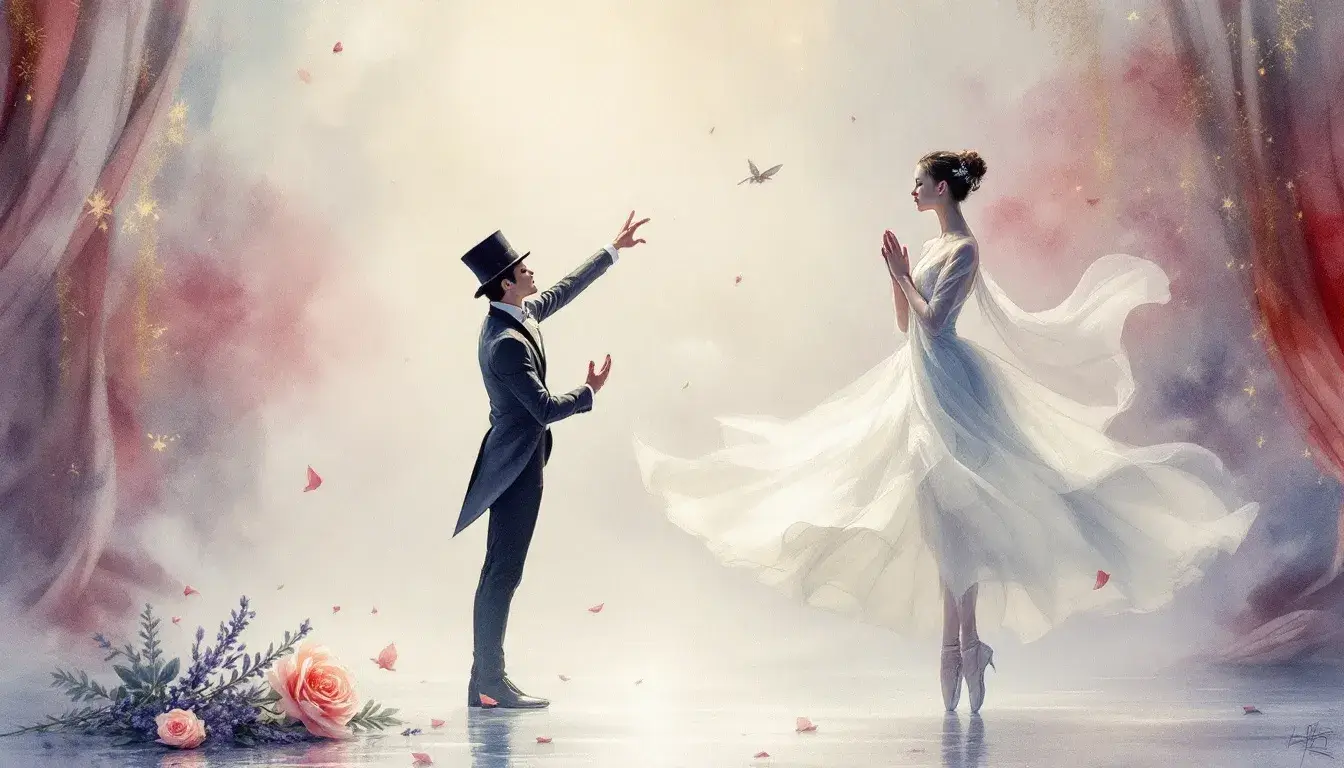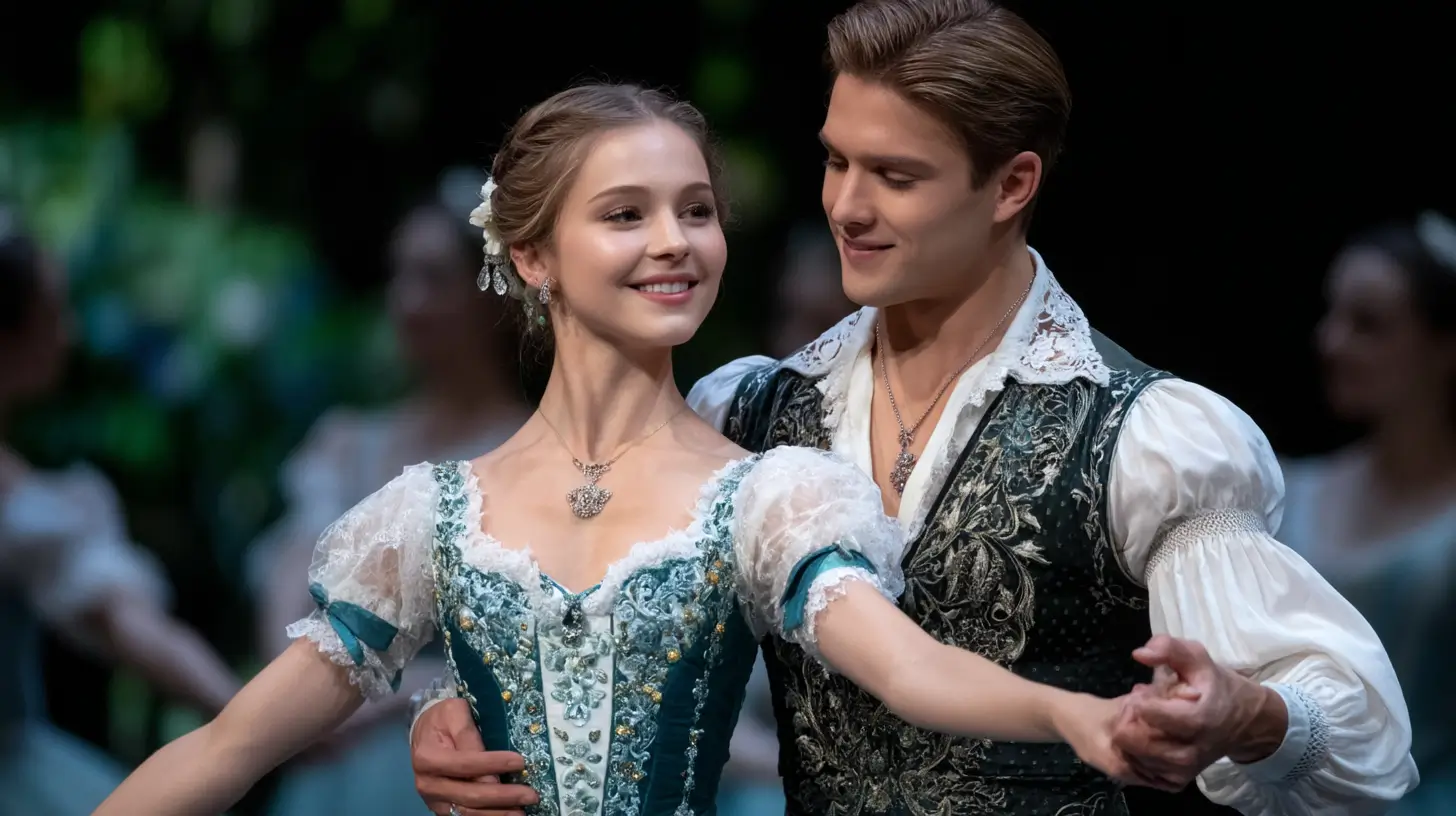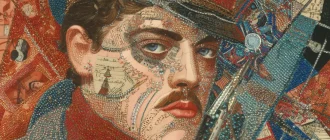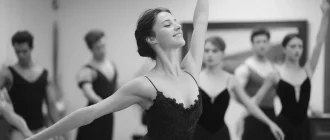La Sylphide is a timeless ballet that has enchanted audiences since 1832. It tells the story of James, a Scotsman torn between his fiancée and a magical Sylphide. This ballet overview will cover its creation, two main versions, plot, characters, music, new choreography, and influence on ballet.
Graceful Insights
- La Sylphide, premiering in 1832, was a landmark ballet that established the Romantic era’s themes of unattainable love and supernatural allure.
- There are two significant versions of the ballet: the original by Filippo Taglioni and an adaptation by August Bournonville. Each emphasizes different aspects of the narrative and choreography.
- La Sylphide’s enduring legacy includes its pioneering use of pointe work and its profound influence on subsequent ballets, altering the dance genre’s narrative structure and thematic depth.
Art de Podcast
| Category | Details |
|---|---|
| Original Premiere | 1832 (Paris Opera, France): Choreographed by Filippo Taglioni and starring his daughter, Marie Taglioni. |
| Notable Revival | 1836 (Royal Danish Theatre, Copenhagen): August Bournonville created a new version that remains widely performed today. |
| Choreographers | Filippo Taglioni (1832 Version): Set the template for the Romantic ballet genre. August Bournonville (1836 Version): Developed a more naturalistic style with Danish technique and phrasing. |
| Composers | Jean-Madeleine Schneitzhoeffer (1832 Version): Delicate, atmospheric score. Herman Løvenskiold (1836 Version): Lyrical and emotive music that accentuates drama and character. |
| Ballet Era & Style | Romantic Ballet (Early 19th century): Emphasized ethereality, supernatural elements, and emotional expression. Light, airy pointework and those of the tutus established the signature Romantic aesthetic. |
| Setting & Locale | The narrative is set in the Scottish countryside, featuring a rustic farmhouse, misty forests, and enchanted woodland realms. |
| Central Characters | James: A young Scotsman betrothed to Effie but enchanted by a Sylph. The Sylph (La Sylphide): A winged forest spirit who captivates James. Effie: James’s human fiancée, a symbol of earthly reality. Madge: A mysterious witch who catalyzes tragedy. |
| Story Summary | On the morning of his wedding, James is visited by a Sylph who enchants him. Torn between his fiancée Effie and the ethereal being, James follows the Sylph into the forest. Manipulated by the witch Madge, James’s attempt to capture Sylph leads to her death, leaving him bereft and alone. |
| Key Themes | Love vs. Illusion: The tension between earthly commitments and spiritual longings. Fate and Consequence: Choices guided by emotion and enchantment end in heartbreak. Nature and Supernatural: Mysterious forces of the forest challenge human will and reason. |
| Innovations & Legacy | Romantic Ballet Icon: One of the first to highlight pointework as an ethereal device. Costuming: The iconic white Romantic tutu introduced by Marie Taglioni reflects delicacy and transcendence. Durability: Bournonville’s version remains part of the core repertory of Danish ballet and is frequently staged worldwide. |
| Influence on Ballet | Set aesthetic standards for the Romantic era, influencing works like Giselle and shaping ballet’s narrative and choreographic language for generations. |
The Birth of La Sylphide

The creative genius of the ballet master Filippo Taglioni created La Sylphide. Premiering on March 12, 1832, at the Paris Opera Ballet marked a revolutionary moment in ballet history. This pioneering piece, characterized by its emphasis on emotional depth and supernatural themes, helped establish the Romantic era in ballet.
The French Revolution profoundly influenced the Romantic era, shaping the themes and emotional intensity of works like La Sylphide. Societal upheaval and artistic disillusionment during the post-revolutionary period in France transformed the cultural landscape.
The chaotic aftermath of the Industrial Revolution influenced artists to explore themes of unattainable love, the supernatural, and emotional turmoil, which are vividly present in La Sylphide.
The premiere of La Sylphide not only showcased the talents of its artistic director and choreographer but also highlighted the remarkable skills of the dancers, particularly Marie Taglioni, Filippo’s daughter. Her portrayal of the Sylphide was so enchanting that it set a new standard for ballet dancers, emphasizing the ethereal and otherworldly qualities that became hallmarks of the Romantic ballet.
La Sylphide’s influence extended beyond just a single performance; it became a cornerstone of the Romantic ballet genre. Its themes of unattainable love, the supernatural, and emotional turmoil resonated deeply with audiences, setting the stage for future ballets that explored similar motifs. The ballet’s success at the Paris Opera Ballet cemented its place in the annals of dance history.
Two Versions of La Sylphide
La Sylphide is unique in that it exists in its original form and two distinct versions, each with its charm and artistic significance. The original version, choreographed by Filippo Taglioni, premiered in 1832 and was a defining piece for the ballet La Sylphide at the Paris Opera Ballet. This version was instrumental in establishing the Romantic ballet’s aesthetic and thematic elements.
In 1836, August Bournonville, the ballet master, presented his adaptation of La Sylphide, which premiered in Copenhagen. With high costs from the Paris Opéra for the original score, Bournonville decided to mount his production. This allowed him to reinterpret the classic tale with new music while maintaining the foundational story set by Taglioni’s original choreography.
Bournonville’s version brought a new dimension to the ballet with its distinctive choreography and emphasis on character development. Bournonville’s adaptation has since become a staple of the Royal Danish Ballet, embodying the Romantic spirit while infusing it with his unique choreographic style.
The key differences between the original and Bournonville’s adaptation lie in their choreography and storytelling approaches. Taglioni’s version focused on the ethereal and supernatural, while Bournonville’s version emphasized human emotions and character interactions. These variations have allowed La Sylphide to remain a versatile and enduring work, appealing to diverse audiences over the centuries.
Synopsis of La Sylphide
The story of La Sylphide revolves around James, a young Scotsman, who finds himself torn between his fiancée, Effie, and an enchanting Sylphide. The ballet opens with James dreaming of Sylphide, who kisses him awake before vanishing, setting the stage for the conflict between earthly love and supernatural allure.
As the narrative unfolds, James’s emotions become increasingly complicated as he navigates his feelings for Effie and Sylphide. This internal struggle is at the heart of La Sylphide, driving the plot forward and leading to the ballet’s dramatic conclusion. The story is divided into two acts, each with its distinct setting and emotional arc.
Act I: The Wedding Preparation
In Act I, the setting is a Scottish farmhouse where James and Effie prepare for their wedding. However, James is distracted by visions of the Sylphide, an ethereal being who has captured his heart. The Sylphide’s enchantment over James grows stronger as she steals his wedding ring, an act that symbolizes her hold on him and foreshadows the conflict to come.
Madge, an old witch and fortune teller, plays a crucial role in this act by adding an element of superstition and foreshadowing. She foretells that Effie will marry Gurn, James’s rival, instead of James. This prophecy sets the stage for the ensuing drama and highlights the themes of fate and destiny throughout the ballet.
The wedding festivities are disrupted when Sylphide appears to James, leading him to pursue her into the forest. This act ends with James torn between his duty to Effie and his longing for Sylphide, setting up the emotional and physical journey that unfolds in Act II.
Act II: The Forest and Tragic End
Act II transports us to an enchanted forest, where James follows the Sylphide, captivated by her ethereal beauty. The forest setting contrasts sharply with the Scottish farmhouse, emphasizing Sylphide’s otherworldly nature and the magical atmosphere that pervades this part of the ballet.
Madge’s deception comes to a head in this act, as she misleads James into using a cursed scarf to capture the Sylphide. Believing that the magic scarf will allow him to hold onto the Sylphide forever, James places it around her shoulders, only to witness her wings fall off and her life fade away. This tragic end underscores the themes of unattainable love and the consequences of meddling with the supernatural.
The act concludes with James alone and heartbroken in the forest, having lost Sylphide and Effie. The haunting image of Sylphide’s lifeless form poignantly reminds us of the dangers of chasing illusions and the inevitability of fate.
Characters and Their Roles
The characters in La Sylphide are richly drawn, each playing a vital role in the unfolding drama. The protagonist, James Ruben, is a young Scottish farmer whose enchantment with the Sylphide drives the plot. His internal conflict between his earthly love for Effie and his supernatural fascination with the Sylphide forms the core of the ballet’s emotional arc.
Madge, the witch, fortune teller, is a pivotal character whose prophecies and manipulations steer the course of events. Her prediction that Effie will marry Gurn instead of James sets the stage for the following tragedy. Madge’s role as the antagonist highlights the themes of fate and destiny, and her actions ultimately lead to Sylphide’s death.
Effie, James’s fiancée, and her friend Gurn, his friend and rival, add complexity to the original story. Effie represents the earthly and attainable love that James is meant to embrace, while his friend Gurn’s desire for Effie creates tension and rivalry. The Sylphide, with her ethereal beauty, symbolizes the supernatural allure that captivates James, leading him away from his destined path.
Music and Choreography

The music and choreography of La Sylphide are integral to its enduring appeal. Jean Schneitzhoeffer composed the original score for the 1832 version, capturing the ballet’s romantic atmosphere with his evocative music. Schneitzhoeffer’s composition enhances the ballet’s emotional depth and ethereal quality, making it a defining work of dance from the Romantic era.
When the Paris Opera’s price for Schneitzhoeffer’s original score was deemed too high, August Bournonville, in his 1836 adaptation, commissioned Herman Severin Løvenskiold to create a new score that reflected the ballet’s Romantic essence.
Løvenskiold’s music incorporates contrasting themes, depicting the ethereal nature of the Sylphide against the lively folk dances of the Scottish characters. His composition features melodramatic elements that elevate the dramatic presentation of the storyline.
Whether in Taglioni’s original or Bournonville’s version, the choreography plays a crucial role in conveying the ballet’s themes and emotions. The use of pointe shoes, introduced during the Romantic era, allows the dancers to portray the lightness and ethereality of the Sylphide, enhancing the supernatural illusion that defines the ballet.
The combination of music and choreography in La Sylphide creates a harmonious blend that continues to captivate audiences.
Costumes and Set Design

The visual elements of La Sylphide, including costumes and set design, contribute significantly to its magical atmosphere. The Sylphide typically wears an ethereal romantic tutu adorned with flowers and pearls, embodying her purity and supernatural essence. This traditional white tutu has become iconic for portraying ethereal characters in ballet.
James and the wedding guests wear costumes influenced by Scottish design, including kilts and traditional attire. These costumes reflect the ballet’s setting and contrast sharply with Sylphide’s otherworldly appearance, emphasizing the earthly and supernatural dichotomy. Using kilts and Scottish patterns adds an authentic touch to the characters and grounds the story in its cultural context.
The set design of La Sylphide includes a Scottish farmhouse and an enchanted forest, creating a vivid backdrop for the unfolding drama. The farmhouse represents the familiar and the mundane, while the forest embodies the mysterious and the magical. This contrast in settings enhances the ballet’s themes of reality versus fantasy and the tension between the known and the unknown.
Notable Productions and Performances

Since its premiere, numerous ballet companies have performed and celebrated La Sylphide. The original production of the national ballet, choreographed by Filippo Taglioni, premiered on March 12, 1832, at the Paris Opera Ballet, marking a significant moment in the history of Romantic ballet. This premiere set the stage for future adaptations and revivals of celebrated works that would keep the ballet alive for generations.
August Bournonville’s adaptation, which the ballet premiered in 1836, has been a cornerstone for the Royal Danish Ballet. With its unique choreography and a new score by Herman Severin Løvenskiold, this Bournonville version has become a hallmark of the company’s repertoire. The Royal Danish Ballet continues to perform Bournonville’s version, maintaining its significance in the ballet world.
One of the notable revivals of the original La Sylphide was staged by the Paris Opera Ballet in 1972, featuring renowned dancers like Erik Bruhn and Lis Jeppesen. This revival by the Opéra National de Paris brought the classic ballet to new audiences, showcasing the timeless appeal of La Sylphide and highlighting the dancing talents of contemporary performers.
Influence on the Ballet World during the Romantic Era

La Sylphide’s influence on the ballet world cannot be overstated. As one of the earliest Romantic ballets, it introduced innovations that have shaped today’s art form.
The ballet’s pioneering use of pointe work allowed dancers to portray ethereal and supernatural characters with lightness and grace, revolutionizing ballet technique. This innovation became a defining feature of the Romantic era, inspiring subsequent generations of dancers and choreographers.
The themes explored in La Sylphide, such as the conflict between humans and supernatural beings and the pursuit of unattainable love, have had a lasting impact on the narrative structure of many ballets. Works like Giselle owe much to the thematic groundwork laid by La Sylphide, which delved deeply into the emotional and fantastical elements that captivate audiences.
Even today, La Sylphide remains relevant through continuous performances and reinterpretations by major ballet companies worldwide. Its ability to evoke emotion and transport audiences to a magical realm ensures its place as a cornerstone of classical ballet. The ballet’s cultural impact extends beyond the stage, influencing literature, film, and other art forms with its timeless exploration of fantasy and romance.
Resume
La Sylphide stands as a testament to the enduring power of Romantic ballet. Its blend of ethereal beauty, emotional depth, and tragic storytelling has captured audiences since its creation by Filippo Taglioni and its significant premiere in 1832. La Sylphide has left an indelible mark on the dance world, from the adaptations and reinterpretations that have followed.
The ballet’s innovative use of pointe work, additional music, and exploration of supernatural themes set new standards for the art form and influenced countless ballets afterward. The characters, music, choreography, costumes, and set design create a magical and unforgettable experience for audiences.
As we reflect on La Sylphide’s legacy, we recognize its profound significance in the history of ballet. It continues to inspire and enchant, proving that the themes of love, loss, and the supernatural are as relevant today as they were nearly two centuries ago. La Sylphide is not just a ballet; it is a timeless journey into the heart of Romanticism.
FAQ
What are the two main versions of La Sylphide, and how do they differ?
The original 1832 version by Filippo Taglioni features Marie Taglioni’s pioneering pointe work set to Jean‐Madeleine Schneitzhoeffer’s score, while August Bournonville’s 1836 Danish revival uses Herman Severin Løvenskiold’s music, simplifies the libretto, incorporates Scottish folk elements, and is the version most commonly performed today.
Who choreographed the original La Sylphide, and for whom was it created?
Filippo Taglioni choreographed the original ballet in 1832 specifically to showcase his daughter’s talents, Marie Taglioni, cementing her status as the era’s leading ballerina.
What is the basic storyline of La Sylphide?
On his wedding morning in a Scottish village, young farmer James is enchanted by a sylph who appears from the forest. He abandons his bride-to-be, Effie, to follow the ethereal spirit, only to fall under a witch’s curse and face tragic consequences.
Who are the main characters in La Sylphide?
The principal figures are James, the Scottish farmer; the Sylph, a mysterious forest spirit; Effie, James’s betrothed; Gurn, James’s friend who also loves Effie; and Old Madge, the village witch whose dark magic drives the drama.
Who composed the music for La Sylphide?
Jean‐Madeleine Schneitzhoeffer composed the score for the 1832 Paris premiere, while Herman Severin Løvenskiold wrote the music for Bournonville’s 1836 Danish production.
Why is La Sylphide considered significant in the history of ballet?
As the first Romantic ballet, La Sylphide introduced themes of the supernatural and emotional expression on pointe, setting the standard for the ethereal “white act” tradition and influencing countless works.
What costume and staging conventions characterize La Sylphide?
The ballet is known for its “ballet blanc” aesthetic, featuring diaphanous white tutus, misty Highland landscapes, and delicate pointe choreography emphasizing the sylphs’ otherworldly grace.
From what sources did Romantic ballets such as La Sylphide derive their plotlines?
Romantic ballets drew on folklore, Gothic literature, and supernatural tales. La Sylphide’s story was adapted from Charles Nodier’s novella “Trilby,” reflecting 19th-century fascination with the ethereal and uncanny.
How does La Sylphide differ from the ballet Les Sylphides?
La Sylphide is a narrative ballet with a tragic plot of love and supernatural conflict. In contrast, Les Sylphides is a non-narrative “ballet blanc” set to Chopin’s music, focusing on mood and atmosphere rather than story.
What are some notable modern productions of La Sylphide?
Key revivals include Pierre Lacotte’s 1972 reconstruction of the Taglioni version in Paris, Johan Kobborg’s 2005 staging at the Royal Opera House, and Matthew Bourne’s 1994 contemporary adaptation titled “Highland Fling.”
What supernatural elements are featured in La Sylphide?
The ballet features sylphs—air spirits embodying freedom and beauty—and the witch Old Madge, whose curse and sorcery underscore the Romantic era’s preoccupation with the supernatural and tragic fate.
Where and when was La Sylphide first performed?
The original premiere took place on March 12, 1832, at the Salle Le Peletier of the Paris Opera, marking a milestone in the evolution of ballet.
How does La Sylphide end?
In the tragic finale, James places an enchanted scarf on the Sylph, causing her to die in the arms of her sisters. The ballet often concludes with James left alone, cursed by Old Madge’s dark magic.
How did La Sylphide influence the development of pointe technique?
Marie Taglioni’s performance in La Sylphide popularized pointe work as a tool for expressive, ethereal movement rather than simply an acrobatic feat, shaping the future of ballet technique.








